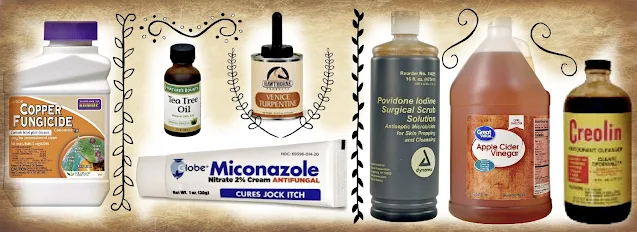These are my various home-made concoctions that I have found very useful to use around the farm.
For the Coat
Fly Spray:
I find the very best and cheapest fly spray to take care of my 7 horses is Apple Cider Vinegar. I frequently add a bit of Healthy Haircare to condition the coat, and sometimes a drop of Pyrethrin concentrate that I ordered off Amazon.com. You can add essential oils (I'd recommend Lemongrass, Cedar, Eucalyptus, Rosemary, Citronella, or Geranium), but this mostly just increases the cost of your fly spray.
Another trick I read about was to boil a strong tea and use that. I did try this once, adding some clippings from my rosemary and wormwood plants. It did a decent job of repelling flys temporarily, but in all honesty, the apple cider vinegar works the best!
Antifungal / Drying Powder:
You can use this to help dry sweat spots on a horse you can't bathe or rinse, to help cure rainrot, or even as a shoe / boot powder (which I do all the time... I have a fear of spiders living in my barn shoes!). I don't have exact measurements, but here is a general guideline:
Mane & Tail lotions -
Detangling:
Okay, here is my secret for detangling knotty manes and tails.... forget your Cowboy Magic, Show Sheen, and other silicone-based products. Find the ethnic hair care section of your local store and pick up some Luster's Pink lotion. I suspect it's the high lanolin content, but I have tried numerous other products, and this is the one that works best! When I need to detangle some knots or burrs, this stuff works better than anything! I have actually tried many hair care products for ethnic and African hair types on the horses, but have yet to find one that works as well as this.
Probably coming in second place for detangling a problem area is WD-40. It also adds a lovely sheen. However, I can't vouch for how safe this stuff is to use... I suspect it's not a great idea to have frequent skin contact with a petroleum-based product (although I could be totally wrong, I'm not a scientist).
General moisturizing:
I frequently make my own all purpose mane & tail lotion by mixing some Pink lotion, cheap hair conditioner, water, and Healthy Haircare. Other ingredients that I may add include olive or castor oils, tea tree oil (for it's anti-fungal properties), and coconut oil (you can now find the liquid-at-room-temperature kind in the grocery store).
Growth / Antifungal:
To be used on just the hair roots, use either straight Listerine (antifungal, and seems to stop flakes and itching), or mix in a bit of Witch Hazel, a few drops of Tea Tree Oil and / or Neem Oil, and the secret ingredient, Miconazole, also known as the vaginal yeast infection treatment found everywhere. Shake to mix it all up well, and be careful with application... one of my horses seemed very sensitive to it, and proceeded to rub his neck and mane on everything he could find, actually causing more hair loss. (Yikes!)
Again, I am far from a scientist, more like a MacGyver wanna-be DIY Kitchen Witch! Use at your own risk.
Hooves
Hoof Oil
This has many of the same ingredients as the mane & tail lotion, only I usually add an anti-fungal and make sure when I apply it to get it into the hair up around the coronet band. This really does seem to prevent hoof cracks from forming, and was recommended by my farrier long ago. Some good anti-fungals are Tea Tree Oil, Miconazole (yes, that's what's in Monistat vaginal cream), copper fungicide, apple cider vinegar, Venice turpentine, Creolin, and iodine. Really, any sort of thick oil seems to make a good base. Again, I love the Luster's Pink lotion because of the lanolin. Many people recommend Listerine, but I haven't used it as I don't believe it mixes well with the oils.
Hoof Hardener
Okay, I found this someplace online when I had a problem with reoccurring hoof abscesses in one of my horses. Be warned, it can be very toxic and dangerous, so if you decide to try this, always wear chemical resistant gloves, protective eye goggles, and be extremely careful how you apply it. It is comprised of equal parts Formalin, Propylene Glycol, and Iodine. (All these things can be purchased from Amazon). ONLY use it on the sole and white line, DO NOT apply it to the frogs - Formaldehyde (which is made into a solution in the Formalin) can be very dangerous to living tissue.
Handle with the same care you would use if it were battery acid! 💀
Hoof Packing
Basically I mix the same anti-fungal ingredients from my hoof oil recipes above with Kaolin or Bentonite Clay powder. Use enough wet ingredients to make it into a sticky mud consistency. This is great, because it sticks really well in the soles of the hooves, you can use it if hooves are damp (do make sure they are picked out clean first), and if they are being turned back out into a muddy area, it will stay in the hoof for a while.














